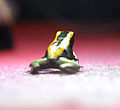Terrible poison dart frog
| Terrible poison dart frog | ||||||||||||
|---|---|---|---|---|---|---|---|---|---|---|---|---|

Terrible poison dart frog ( Phyllobates terribilis ) |
||||||||||||
| Systematics | ||||||||||||
|
||||||||||||
| Scientific name | ||||||||||||
| Phyllobates terribilis | ||||||||||||
| Myers , Daly & Malkin , 1978 |
The terrible poison dart frog ( Phyllobates terribilis ), also known as the terrible poison frog , terrible leaf climber , yellow leaf climber , golden poison frog , lemon yellow leaf climber or golden leaf climber , is one of the most poisonous animals and the most poisonous species of frog . They were used as poison dart frogs by the Chocó Indians of Colombia , as well as by other indigenous peoples of South America, particularly poisonous species of the tree dart frogs (Dendrobatidae), to impregnate blowpipe arrows with their skin venom . Animals in captivity lose their poison, their offspring are non-toxic. For the synthesis of the poison ( batrachotoxin ), alkaloids of special tropical feed insects are required.
description
The terrible poison dart frog is up to five centimeters long and is one of the largest representatives of the poison dart frog. The females are, on average, slightly larger than the males. The body is uniformly yellow, metallic yellow-green or orange, rarely gray. In contrast to other Phyllobates species, the ventral side and legs are only slightly darker. The young animals are colored differently than the adult specimens. They are black with two stripes on the back.
Occurrence and way of life
The terrible poison dart frog only occurs in a very small area around the Rio Saija near the Pacific coast of Colombia in the Cauca department. The area has hills up to 200 m high. The frogs inhabit the tropical rainforest there and live primarily on the forest floor and near rivers. They are diurnal solitary animals outside of the mating season. The population density should be very high within the small distribution area.
The males have sound bladders with which they generate trilling calls during the breeding season. The eggs are laid on land. The hatching larvae are taken on their backs by the males and transported to permanently water-bearing bodies of water, where they go through their tadpole phase.
The IUCN classifies Phyllobates terribilis as endangered because of its small distribution area .
literature
- Ralf Heselhaus: poison dart frogs. Eugen Ulmer Verlag, Stuttgart 1988, ISBN 3-8001-7937-7 .
Individual evidence
- ↑ Treatise on the poison on froschkeller.de (as of November 8, 2007)
- ^ BR-Online category: Environment & Health ( Memento from August 2, 2003 in the Internet Archive ) (Status: November 8, 2007)
Web links
- IUCN Redlist: Phyllobates terribilis (Engl .; including distribution map)
- Phyllobates terribilis at www.t-eisenberg.de
- World Association of Zoos and Aquariums



